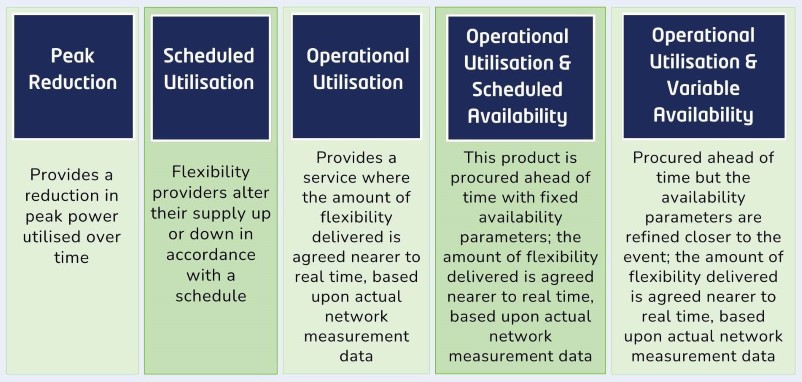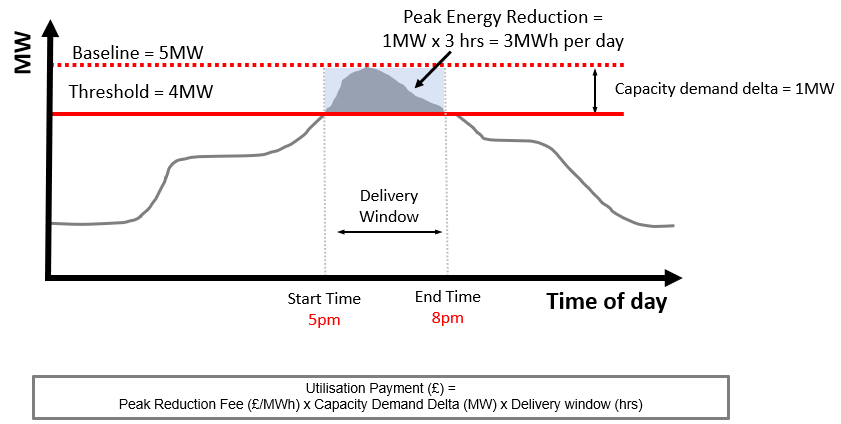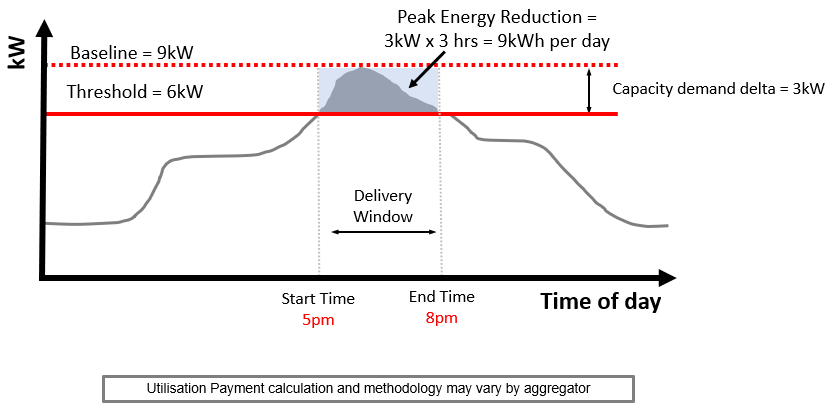Homeowner case study
Introduction
A homeowner is looking to participate in the flexibility services market (via an aggregator through a Peak Reduction contract) by reducing their electricity demand during peak hours, providing additional capacity to help manage network constraints.
About flexibility services
When the demand for electricity is greater than the amount that SP Electricity North West can provide, we procure flexibility services to alleviate constraints on our network during peak times. These services are provided by companies or individual customers known as flexibility services providers (FSPs), who own assets in our region such as generators, battery storage and electric vehicle (EV) charge points. FSPs should be able to generate more, or use less, electricity during a pre-agreed service delivery window, and provide at least 10kW of flexibility capacity either individually or via an aggregator. This allows us to balance supply and demand, ensuring a safe and reliable supply of energy for our customers. In return for providing extra capacity, FSPs receive payment from SP Electricity North West.
Delivering a Peak Reduction service via demand reduction
Homeowners can participate in demand response flexibility services using a number of their assets, such as EV charge points, heat pumps, adjustable thermostats, air conditioning, smart appliances, batteries, etc. These are processes and assets whose electricity demand can be adjusted for short periods with no impact on the homeowner's day-to-day operations. In this example, the homeowner has a heat pump and an EV charge point installed at their house which they can control to manage their total demand profile as and when required (site metering).
As the maximum volume of flexibility that the homeowner can offer is below 10kW, which is the minimum capacity required to participate individually in our flexibility services, they decide to participate via an aggregator.
An aggregator is a company that essentially pools smaller assets (<10kW) into a portfolio which then allows them to participate in flexibility service products with higher entry thresholds (i.e. ≥10kW). For example, an aggregator's capacity could be 1,000 EVs or 200 household heat pumps. The aggregator monitors when the price of electricity is high and then disconnects the pre-agreed demand of the consumers in its portfolio, or similarly increases their demand when electricity prices are low.
Pre-tender
Our tenders are published on the ElectronConnect platform twice a year in spring and autumn in line with our Network Development Plan (NDP) and Distribution Future Electricity Scenarios (DFES) publications to reflect our latest network requirements. To be notified of our upcoming tenders, the homeowner/aggregator signs up to our flexibility mailing list.
Before the launch of the tender, the homeowner:
- Will carry out market research for potential aggregators such as electricity suppliers to identify the best demand response programmes for their house. During consultations, aggregators typically help potential customers establish how much flexibility their site is able to offer, which services are the best fit, and how much they can earn.
- Registers their house onto an aggregator’s platform, submitting the relevant information.
- The aggregator’s engineering team will likely carry out a site visit and an engineering assessment and will install and commission any additional metering and control systems required to participate in the chosen demand response programmes.
Before the launch of the tender, the aggregator:
- Registers the company on ElectronConnect to pre-qualify to participate. The information submitted such as credit checks and insurance details is assessed by SP Electricity North West. Once approved, the company's commercial qualification remains valid for future tender rounds
- SP Electricity North West utilises the framework style Standard Flexibility Services Agreement developed by the Energy Networks Association Open Networks Project. The aggregator can sign up to the general T&Cs of this agreement as part of commercial qualification, and a signed copy must be returned via Electron before placing a bid. The homeowner does not enter into contract directly with SP Electricity North West.
- Registers its portfolio of asset(s), which includes the homeowner's asset, onto ElectronConnect.
Tender process

Pre-qualification
Once the Invitation to Tender (ITT) has been published, the aggregator reviews the requirements using the map included in our latest flexibility service requirement. Once it has established that its sites are located within a requirement zone seeking a Peak Reduction service, it calculates how much of the required demand response it can offer, when, and at what price. Before submitting a bid, the aggregator uses the cost calculator tool on our website to check that the prices it is prepared to offer for availability and utilisation don't exceed the ceiling price that we are offering for the service as part of this tender round. The cost calculator can be found in the ITT appendices for our latest flexibility services requirement. At this point, the aggregator decides it would like to participate in the tender.
The next step for the aggregator is to complete technical qualification on ElectronConnect by confirming the assets it wishes to put forward in the competition. SP Electricity North West then assesses the technical details of the participating assets and the capability for delivery. The aggregator is notified via ElectronConnect that its assets meet the requirements of the tender, allowing it to move to the bidding stage of the process.
Submitting a bid
For the final stage of the procurement process, the aggregator submits a bid to the tender via the ElectronConnect platform. This is done by linking the pre-registered assets to the peak reduction payments, as well as the periods where the homeowner can commit to reduce their demand peaks. Once the bidding window has closed, SP Electricity North West assesses the tender responses before accepting or rejecting bids based on the proposed payment and the asset's ability to meet the specification. If the aggregator's bids are successful, it will then enter into a flexibility services agreement with SP Electricity North West to deliver the service within the required service windows.
Helpful tips to consider before submitting a bid
- When calculating the tender bid prices the aggregator/homeowner should consider the cost of lost revenues, fuel costs, environmental or permit fees, initial set up costs, maintenance, other revenue streams available, energy savings benefits etc.
- When thinking about the utilisation periods the aggregator/homeowner should consider the practicalities of these periods, the processes required to ensure that the service can be delivered, seasonal considerations e.g. increased demand during large televised events, Christmas period, weather-related issues (e.g. extreme cold weather increasing the heating demand) and maintenance periods.
Flexibility service products
SP Electricity North West procures four common products (services), which align with the Open Networks service definitions:
- Peak Reduction
- Scheduled Utilisation
- Operational Utilisation
- Operational Utilisation & Variable Availability.

The Peak Reduction product is a pre-fault product that seeks a reduction in peak power utilised over time but specifically during high peak periods. Participants in this service are required to keep their peak demand below a pre-defined threshold during pre-scheduled service windows (typically at peak times, e.g. 4pm-8pm). This could be provided by demand turn-down or load shifting where the customer's energy use is spread out throughout the day, allowing us to operate our equipment more efficiently and release additional capacity to our network for new connections.
Dispatch
Utilisation instruction timings are agreed at time of trade so the aggregator can pre-schedule utilisation with the assets.
Worked example 1: Aggregator
An aggregator has entered into a flexibility services agreement with SP Electricity North West to reduce the peak demand of its asset portfolio during a pre-determined period. The normal electricity demand from that portfolio is 5MW and operates 24/7. Under the contract with SP Electricity North West, the aggregator has committed to keep the portfolio’s maximum electricity demand below 4MW, between 5pm-8pm, on weekdays between November-March.
If the aggregator manages to prove that the portfolio’s demand does not exceed 4MW during this period, it will get paid for 1MW of service x three hours per day x five days per week = 15MWh per week.
SP Electricity North West will not provide a dispatch command. It is expected that the aggregator will keep its peak demand below the contracted threshold during the determined service windows.

Worked example 2: Homeowner
A homeowner has entered into a flexibility services agreement with an aggregator to reduce the peak demand of their house during peak times. The normal peak electricity demand from the house is 9kW. Under the contract with the aggregator, the homeowner has committed to respond to the aggregator’s dispatch signals for demand reduction by limiting their peak demand to less than 6kW, between 5pm-8pm, on weekdays between November-March.
Aggregators can either directly control the customer's assets to allow for optimum demand reduction during an event, or dispatch signals to allow the customer to perform control. This should be determined in the contract between the homeowner and the aggregator.
At the end of each month (or as determined in the contract between the homeowner and the aggregator), the aggregator will review the homeowner’s metering data to calculate actual demand reduction during any demand response events. The homeowner will receive payment from the aggregator on successful delivery of services, i.e. for responding to the aggregator’s demand reduction requests. An example is shown below.
If the homeowner successfully manages to stay below the 6kW demand level during this period, they will get paid by the aggregator for 3kW of service x three hours per day x five days per week = 45kWh per week. Outside of this peak period, the homeowner is free to operate their assets as they wish.

Baselining
A baseline is a reference used to measure the amount of flexible capacity delivered to the network by FSPs. There are different kinds of baselining methodologies used depending on the type of asset and service being provided. These include historical baselines (using past meter readings to estimate the baseline using standard algorithms) and nominated baselines (using other forecasting techniques such as weather-based models to estimate the future baseline). The baselining methodology will be agreed between SP Electricity North West and the aggregator post contract award and at least six months before the first utilisation period. More information on the different types of baselining methodologies can be found on our FAQs page.
Invoicing
Subject to the delivery of flexibility services, the aggregator will invoice SP Electricity North West and will receive payment by bulk electronic clearing (BACS) by the end of the following month (after the invoice is received). The homeowner will receive payment from the aggregator on delivery of their services.
It is noted that:
- Over-delivery is not paid and cannot be used to compensate for under-delivery during another dispatch request.
- The aggregator is not entitled to any payment during the response time.
For aggregators, more details on invoicing and payment can be found in the terms and conditions of each Invitation to Tender. For homeowners, these details should be found in the terms and conditions in the aggregator's agreement.
Useful links
Register for updates
Sign up to our flexibility services mailing list to find out about new requirements and receive invites to our events.
Get in touch
If you would like to leave feedback, book a meeting with a member of our team or if you have any questions about flexibility services, please get in touch.